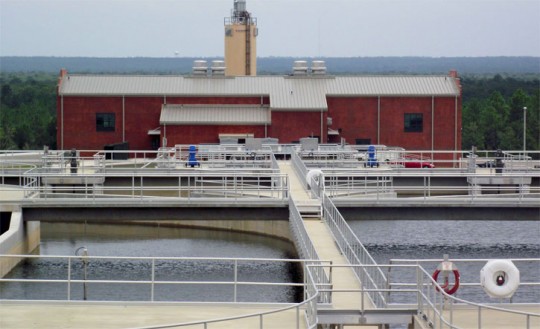Millions Of Gallons Of Reclaimed Wastewater Put To Use
November 12, 2010
Millions of gallons of reclaimed water now are flowing from the Emerald Coast Utilities Authority’s new Central Water Reclamation Facility in Cantonment to Gulf Power, a partnership that company officials said is bringing cleaner air and water to Northwest Florida.
Gulf Power’s Plant Crist has started receiving up to 10 million gallons a day of reclaimed water from ECUA’s new plant through a four-mile pipeline connecting the two facilities in Cantonment. The water is being used for the scrubber system at Plant Crist and for generating electricity.
The scrubber system, which cost $645 million and started operating last December, reduces regulated air emissions from Plant Crist by more than 95 percent. And, because of the partnership, Gulf Power will reduce the amount of water it takes from the Escambia River by about 10 million gallons a day.
“We’re giving this reclaimed water a beneficial use while conserving a valuable natural resource,” said Sandy Sims, Gulf Power Public Affairs manager. “While our scrubber has been providing cleaner electricity for almost a year now, this innovative project shows how partners can work together to benefit our customers and the environment — with cleaner air and water.”
The partnership earned Gulf Power and ECUA a 2010 Sustainable Florida Best Practices Award from the Florida Collins Center for Public Policy.
Gulf Power eventually will use up to 17 million gallons a day of reclaimed water, of which more than 80 percent will be evaporated as part of the scrubber, cooling tower and plant operations.
The new ECUA facility eventually will replace the Main Street Wastewater Plant, which had been discharging up to 20 millions of gallons of effluent daily into Pensacola Bay, and stands in a coastal flood zone, vulnerable to storm surge. The new wastewater treatment plant is a zero discharge facility.
Pictured above and below: The Central Water Reclamation Facility in Cantonment. Submitted photos for NorthEscambia.com, click to enlarge.
Comments
12 Responses to “Millions Of Gallons Of Reclaimed Wastewater Put To Use”





Thanks, Nathalie, even if you do type faster than you think. I appreciate the input.
David for information officers
Sometimes, I type faster than I think…that should be irrigation, but I think you all knew that..
DeBugger- there will be no reclaimed water going into the Escambia River. All the reclaimed water will be usedinitially by Gulf Power and then by IP, who will take what is available after GP’s consumption. Anything that they cannot accept on any given day will go to the spray fields on the plant site.
-NRB-
Gulf Power will eventually use 17 million gallons per day (mgd); up to 6 mgd will then be available to International Paper for use in their process. 80% of reclaimed water to GP will evaporate, the remaining 20% will be captured and sent back to ECUA’s CWRF for retreatment. This will basically be a closed-loop process.
DeBugger- We do not have any deep well injection processes, you might be thinking of the Ascend Materials plant…
We have 2,000 acres available for sprayfields to dispose of the reclaimed water in the event that some of all of it cannot be accepted by GP or IP, which can happen from time to time in industrial processes.
CWRF will be treating to the highest standard- AWT (Advanced Wastewater Treatment) making the reclaimed water suitable for direct contact with people. This is water used in golf course irragatiuon, etc. The final step in the reclaimed water process is chlorination.
I hope this answers a few questions. I’d have chimed in earlier but my internet access was down.
Frank, I think you’re referring to the water that leaves the treatment plant & doesn’t go to Crist.
I was wondering about the 20% used by the Crist plant that doesn’t evaporate. I have my doubts about “reclaimed water” being clean enough to pump directly into any free-flowing water system.
But that’s the way things are done, eh?
sounds right
Big Plants….Big Money…..
Dirty Plants….Dirty Money
IT’S ALL THE SAME OLD STORY WHEN YOU CAN’T TRUST GOVERNMENT!
My understanding in past articals is the remaining 20% will be spred over a man made wetlands….Just saying!
You can throw a rock from here to the Es River. I still won’t be fishing anywhere near there.
REGARDING:
“any word on what happens to the other 20%”
at a guess, it’s already clean enough to put in Escambia Bay, just like Century, Flomaton and Brewton do via Escambia River, so that’s likely the next stop in the water cycle
David for sharing
Thank you for the septic tank comment! You are right on target!
Hey Will—
any word on what happens to the other 20%? Are they going to continue to use the awful deep-well injection method to dispose of their dirty water?
Main Street Wastewater Plant, which had been discharging up to 20 millions of gallons of effluent daily into Pensacola Bay. This is the problem, companies discharging waste in our waters, NOT our septic tanks!